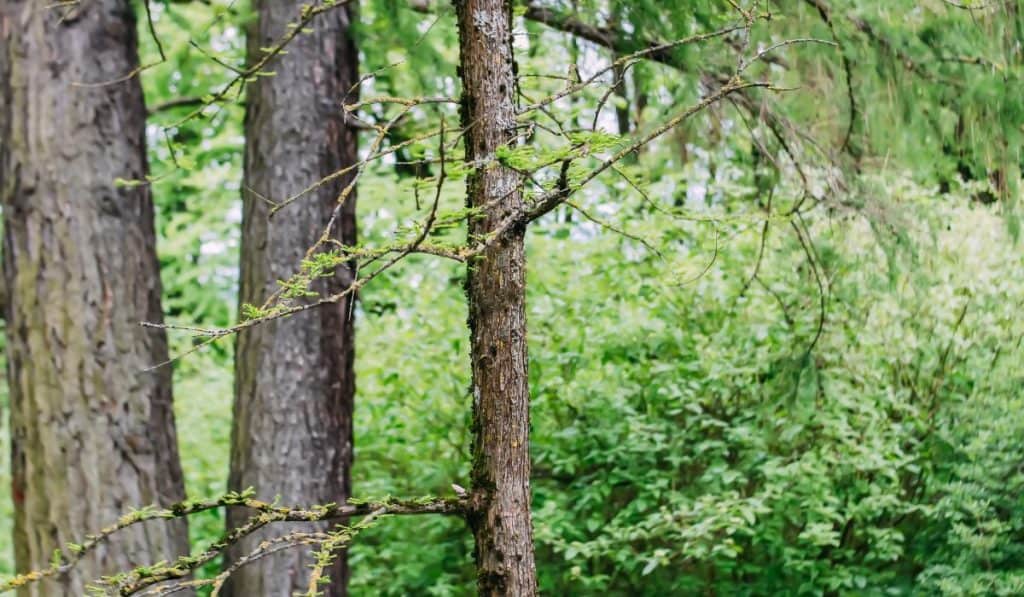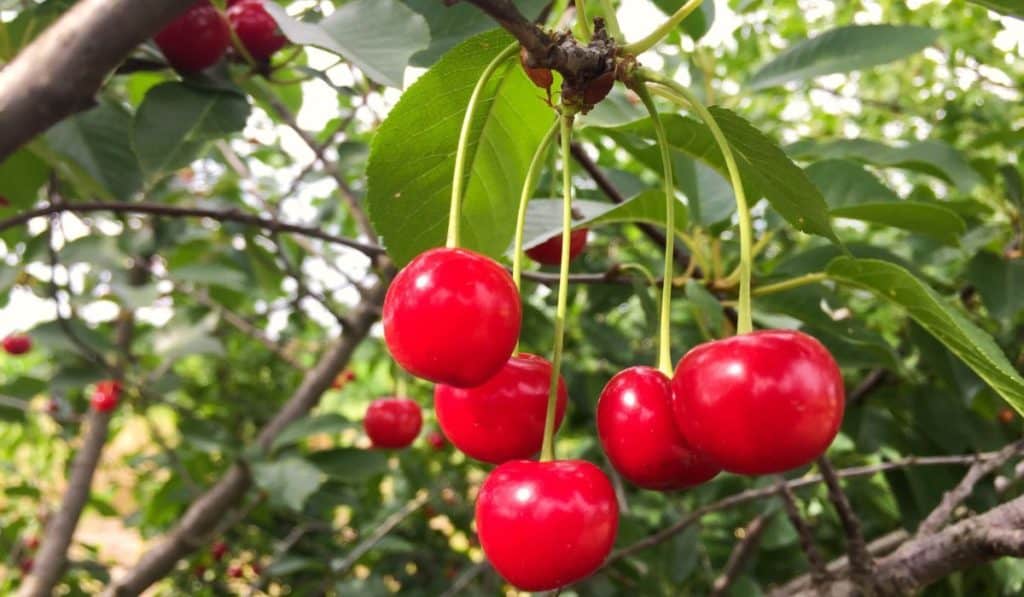Believe it or not, you can actually eat many kinds of tree bark. The most edible part is the cambium, which is the living layer growing under the outer bark. This material is comparably very soft and tender. It’s often sweet, and sometimes bitter. Not only that, but it’s full of vitamins and calorie-rich, energizing natural sugar.
This cambium (tree bark) can be enjoyed plain or incorporated into dishes. Pine is arguably the most popular. Learn more!
You Can Eat Tree Bark
Not only can you eat tree bark, but humans have been doing it for thousands of years. Many Native Americans have used it as a dietary supplement, with Algonquin being referred to (rudely) as ‘tree-eaters.’ Yet, they were wiser than these people knew!
The inner layer of tree bark, known as cambium, is edible and even nutritious, though not a lot can be said about the flavor. Depending on the tree, cambium can be juicy, starchy, sweet, or bitter.

It’s said to be a good source of both vitamins and calorie-rich sugar. This is thanks to ‘phloem,’ which runs through the cambium, carrying food to the rest of the tree. In this way, it’s sort of like eating an egg yolk!
Cambium is a potential source of sustenance year-round. Some animals, like bears, rabbits, beaves, and deer eat it, especially in the winter.
Some seasonings are also made out of the outer bark. In fact, cinnamon comes from the Cinnamon Tree (also known as the Ceylon Cinnamon Tree).
Disclaimer: Never eat anything ( Including tree bark ) if you are unsure if it will harm you or not.
What Ways Can You Eat Tree Bark?
Tree bark can be chewed plain, like gum, to extract the juice and starch, which are full of nutrients and sugar. Or, it can also be made into strips and boiled, for a woody pasta. Many also prefer to enjoy tree bark in the form of a dried powder.
This can serve as a sort of nutritious flour. You can use bark it to thicken soups, make it into bread, and more!
Aromatic cambium and bark, such as that from pine or spruce, can also be made into a fragrant, healthy, forest-flavored tea. Who knew?
Which Trees Have Edible Bark?
1) Pine Trees (Most But Not All)
Most varieties of pine are edible, as are their lookalikes, fir, and cedar. Pines can be recognized by their distinctive needles and curling bark. Toxic pines are the Monteray, Lodgepole, and Ponderosa pines. Also, the yew pine (which is not actually a true pine).
Of all the edible trees, pine trees are the most popular. White Pine is especially resinous, with a strong but not unpleasant flavor. Some places use pine bark extract in their medicine for its anti-oxidants and anti-inflammatory properties, most notably in the UK.
In survival scenarios, it can be a viable source of nutrients and sugar. For recreational purposes, it is said to make a fragrant tea and unique, woodsy pasta. Who knew?
2) Slippery Elm
Slippery Elm is so-named for its slippery cambium under the bark. This cambium is nice and edible and known for its earthy, nutty flavor. It’s often enjoyed dried as flour in bread, soups, or gruel.
This being said, people consume Slippery Elm for its medicinal properties above all. It has potently soothing anti-inflammatory effects, and has been used to treat digestive upset, burns, ulcers, and more (once again, before using any wild herb medicinally, do your research and maybe check with your doctor).
3) Black Birch
Like all birch trees, black birches have that distinctive, papery outer bark that seems to peel right off. It’s a dark gray to brown in color.
Black birch is best known for its mild, minty flavor. It is a bit tough, however, making it difficult to chew. It is more suitable for use as a flour, and soup or bread thickener.
This tree is not only edible but is also anti-inflammatory. People have used it to help with a variety of ills, including diarrhea, worms, and more. As always, be aware of potential allergic reactions and use caution when using medicinally, however (you may wish to first consult with your doctor).
4) Red Spruce Trees

Red spruce cambium is said to be particularly tender. This makes it easier to chew than some, though it is said to have a very strong flavor. It’s an acquired taste, perhaps too pungent plain except in situations of survival, but delicious in teas and pounded as a fragrant kind of flour. It’s full of starch and sugar.
5) Yellow Birch Trees
Yellow Birch, like most kinds of Birch, is easily identified by its curling, paper-like bark! The cambium beneath is by some considered a treat, thanks to its minty, wintergreen flavor. Some even say you can detect notes of rootbeer.
Medicinally, Yellow Birch is anti-inflammatory. It’s also highly nutritious, as it is full of vitamins and natural sugar!
6) Maple Trees
You’re sure to recognize a beautiful maple tree. These silver-barked trees have big, widely-toothed leaves that are often replicated in art and decor. Some maples even have red leaves year-round (and most turn red in the autumn time).
Maple cambium is very chewy, and best enjoyed dried and powdered to use in bread and flour. It has a medium sort of flavor; not very sweet, not very bitter. Some say you can catch hints of maple, but who knows?
When used with medical direction, maple is said to have anti-inflammatory properties, and to help regulate blood sugar (some diabetics opt to use it).
7) Willow Trees
Willow trees are best-known for their drooping, wand-like branches. Willow cambium is edible, but generally not suitable for eating in large amounts. This is due to its incredibly bitter, rather spicy flavor. Not only that, but it can be harmful to consume too much of the bark, which is primarily used as a natural pain-reliever. It will affect the kidneys similarly to an excess of any kind of pain killer (Ibuprofen, Asprin, etc.).
8) Elm Tree
Elm Trees grow 80 to 100 feet, and have deeply-furrowed, oval leaves, and classic, seamed bark.
The cambium of an Elm Tree is exceptionally sweet (as far as cambium goes), with no aftertaste of bitterness. It is quite tender and may become jelly-like as you chew!
In fact, Elm Tree cambium contains a natural lubricant, which, when consumed, can be useful in helping treat digestive disorders (such as IBS).
Which Trees Have Poisonous Bark?
1) Yew Trees
Yew trees grow with a profusion of sprawling needles and rope-like bark. Once you’ve seen it, you’ll remember what to look for.
Unlike many members of the evergreen family, Yew is not edible and is in fact toxic. This is due to taxine alkaloids, which are present everywhere in the tree except the outer fruit.
The taxine alkaloids absorb rapidly into the bloodstream and can cause respiratory failure and cardiac arrest. It’s definitely not something you’d want to try as a snack!
2) Cherry Trees

While cherry fruit is generally non-toxic, and delicious, cherry tree bark is another matter. It contains cyanide, as do the leaves, a highly poisonous compound. It inhibits the body’s absorption of oxygen and can cause respiratory failure and cardiac arrest.
3) Manchineel Trees
The Manchineel Tree, despite its charming appearance, is one of the most poisonous trees in the world. Why? Because the entire tree, leaves, apple-like fruit, and bark, contain a milky-white sap that is chock-full of toxins.
Simply coming in contact with it can cause blisters on the skin. When ingested, it will cause internal bleeding, gastroenteritis, and shock. The unfortunate who have sampled them say that Manchineel fruit has a tasty, sweet flavor… but they’re potentially fatal. So probably not worth the risk!
4) Eucalyptus Trees
You are no doubt familiar with fragrant, aromatherapeutic eucalyptus oil. This is a strong, rather minty scent that people seem to either hate or love! While eucalyptus can be fine when diluted and inhaled as a vapor, it is extremely toxic when ingested.
Consuming eucalyptus will cause nausea, vomiting, and other severe intestinal distress, and even send you into a coma. No matter how good it smells, you will not want to sample this tree’s bark!
How Should You Harvest Cambium and Tree Bark?
As you can imagine, trees need their bark. This means that you’ll want to harvest no more than a small amount. This will give the tree time to regrow, and you can harvest again as soon as the following year.
Generally, it’s advisable to take only a palm-sized portion of bark from each tree. Then, move on. Harvesting more than this can create wounds that allow in viruses and pests, and weaken the tree’s defense system overall.
To harvest, get a sharp, sanitized knife and cut about 1-inch deep into the softest part of the bark. Carve out your palm-sized amount. Eat plain, or prepare it in a dish, and enjoy the unique flavor and health benefits it has to offer!
As you can see, not only is tree bark cambium edible, it’s actually quite nutritious. Some even like the flavor. What do you think? Do you feel like eating some tree bark?




